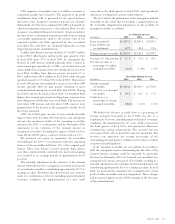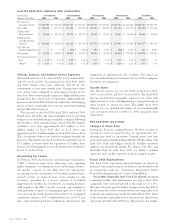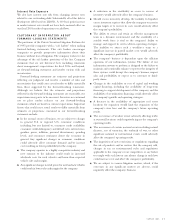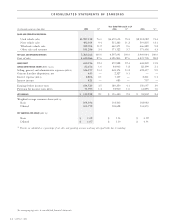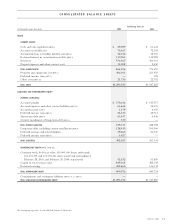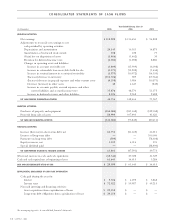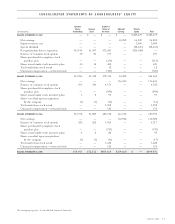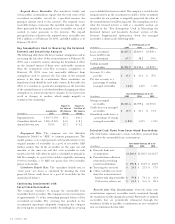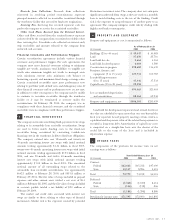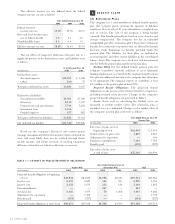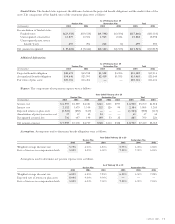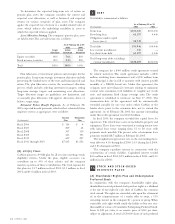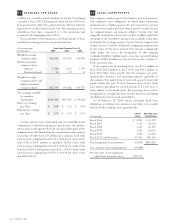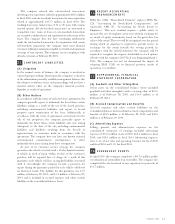CarMax 2005 Annual Report Download - page 35
Download and view the complete annual report
Please find page 35 of the 2005 CarMax annual report below. You can navigate through the pages in the report by either clicking on the pages listed below, or by using the keyword search tool below to find specific information within the annual report.
CARMAX 2005
33
to new car inventory cost when achievement of volume
thresholds is determined to be probable.
(G) Property and Equipment
Property and equipment is stated at cost less accumulated
depreciation and amortization. Depreciation and amortization
are calculated using the straight-line method over the assets’
estimated useful lives. Property held under capital lease is stated
at the lower of the present value of the minimum lease
payments at the inception of the lease or market value and is
amortized on a straight-line basis over the lease term or the
estimated useful life of the asset, whichever is shorter.
(H) Computer Software Costs
External direct costs of materials and services used in the
development of internal-use software and payroll and payroll-
related costs for employees directly involved in the development
of internal-use software are capitalized. Amounts capitalized are
amortized on a straight-line basis over a period of five years.
(I) Goodwill and Intangible Assets
The company reviews goodwill and intangible assets for
impairment annually or when circumstances indicate the
carrying amount may not be recoverable. As of February 28,
2005, and February 29, 2004, no impairment of goodwill or
intangible assets resulted from the annual impairment tests.
(J) Defined Benefit Plan Obligations
Defined benefit retirement plan obligations are included in
accrued expenses and other current liabilities on the company’s
consolidated balance sheets. The defined benefit retirement
plan obligations are determined by independent actuaries using
a number of assumptions provided by the company. Key
assumptions used in measuring the plan obligations include the
discount rate, the rate of salary increases, and the estimated
future return on plan assets.
(K) Insurance Liabilities
Insurance liabilities are included in accrued expenses and other
current liabilities on the company’s consolidated balance sheets.
The company uses a combination of insurance and self-insurance
for a number of risks including workers’ compensation, general
liability, and employee-related health care benefits, a portion of
which is paid by associates. Estimated insurance liabilities are
determined by considering historical claims experience,
demographic factors, and other actuarial assumptions.
(L) Impairment or Disposal of Long-Lived Assets
The company reviews long-lived assets for impairment when
circumstances indicate the carrying amount of an asset may not
be recoverable. Impairment is recognized when the sum of
undiscounted estimated future cash flows expected to result
from the use of the asset is less than the carrying value.
(M) Store Opening Expenses
Costs relating to store openings, including preopening costs, are
expensed as incurred.
(N) Income Taxes
Deferred income taxes reflect the impact of temporary
differences between the amounts of assets and liabilities
recognized for financial reporting purposes and the amounts
recognized for income tax purposes, measured by applying
currently enacted tax laws. A deferred tax asset is recognized if
it is more likely than not that a benefit will be realized. Tax law
and rate changes are reflected in the income tax provision in the
period in which such changes are enacted.
(O) Revenue Recognition
The company recognizes revenue when the earnings process is
complete, generally either at the time of sale to a customer or
upon delivery to a customer. As part of its customer service
strategy, the company guarantees the vehicles it sells with a 5-day
or 250-mile, money-back guarantee. If a customer returns the
vehicle purchased within the limits of the guarantee, the
company will refund the customer’s money. A reserve for returns
is recorded based on historical experience and trends.
The company sells extended service plans on behalf of
unrelated third parties. These service plans have terms of
coverage from 12 to 72 months. Because these third parties are
the primary obligors under these service plans, commission
revenue is recognized at the time of sale, net of a reserve for
estimated customer returns of the service plans. The reserve for
returns is based on historical experience and trends.
(P) Advertising Expenses
All advertising costs are expensed as incurred. Advertising expenses
are included in selling, general, and administrative expenses in
the accompanying consolidated statements of earnings.
(Q) Net Earnings Per Share
Basic net earnings per share is computed by dividing net
earnings by the weighted average number of shares of common
stock outstanding. Diluted net earnings per share is computed
by dividing net earnings by the sum of the weighted average
number of shares of common stock outstanding and dilutive
potential common stock.
(R) Stock-Based Compensation
The company accounts for its stock-based compensation plans
under the recognition and measurement principles of
Accounting Principles Board (“APB”) Opinion No. 25,
“Accounting for Stock Issued to Employees,” and related
interpretations. Under this opinion and related interpretations,
compensation expense is recorded on the date of grant and
amortized over the period of service only if the market value of
the underlying stock on the grant date exceeds the exercise
price. No stock option-based employee compensation cost is
reflected in net earnings, as options granted under those plans
had exercise prices equal to the market value of the underlying
common stock on the date of grant. The following table
illustrates the effect on net earnings and net earnings per share
as if the fair-value-based method of accounting had been


